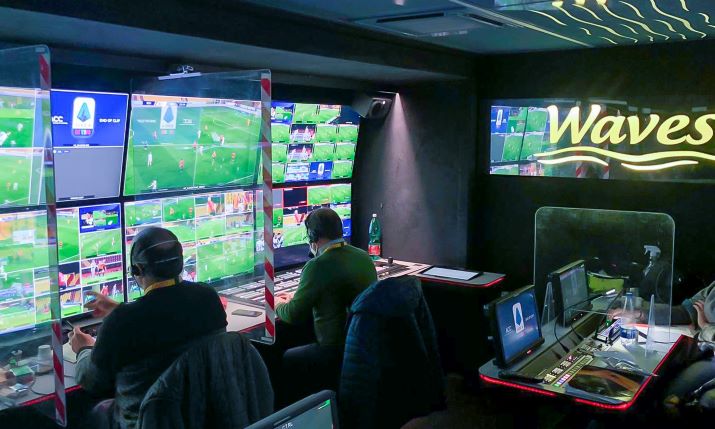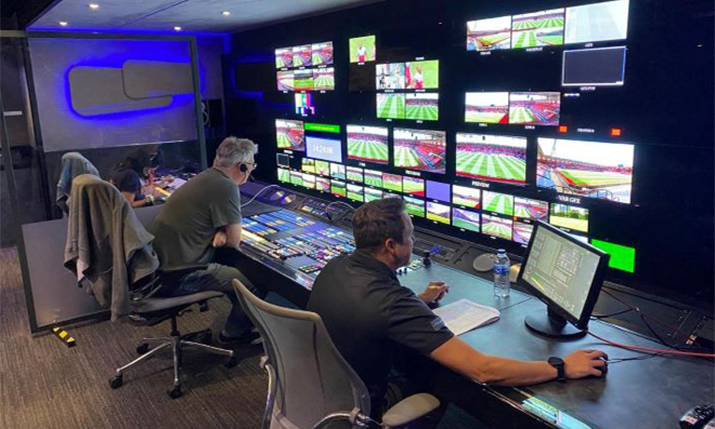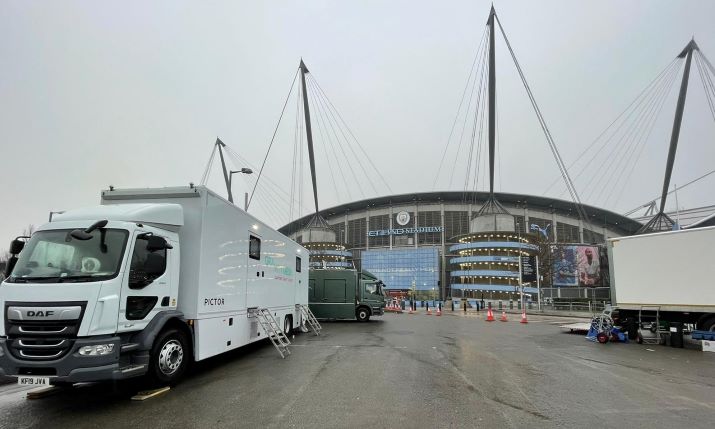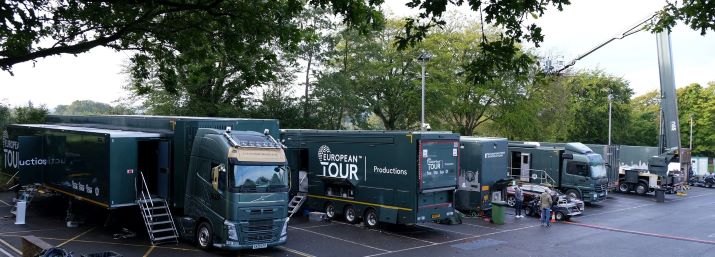Under the hood of OBs Part 1: Exploring the rapid evolution of today’s OB usage in Europe

Italian OB firm, Cinevideo’s new Waves 12G truck, kitted and and ready for safe operation
Outside broadcast services have never been more in demand than they are today. The pandemic has created new opportunities for service provision as live sport attempts to recoup time lost to lockdowns, and broadcasters battle between schedules, COVID protocols, and new remote productions.
In this article, the first of two, we talk to a panel of experts from the OB industry to find out how OBs are being used across Europe today, what demand is being seen, and where small trucks are stepping into the breach.
Tricky times
On how truck usage has changed over the last year, Christer Pålsson, president of NEP Central and Southern Europe, comments: “The past six to nine months have been some of the busiest in recent memory. Due to the rescheduling of the sporting calendar, we’ve seen a huge peak in demand all over Europe.
“However from a regional perspective, we’ve noticed demand coming in waves. So with the Nordics being one of the first [regions] to reopen, we saw a large number of sporting fixtures shift to that region as federations looked to clear the backlog.
“To cater for this our fleet has never been more European, with trucks regularly moving across the continent to cater for the demand,” continues Pålsson. “Of course trucks are easy to move, but people are more challenging, and being a responsible company we’ve done our best minimise cross border travel for people and have tried to crew all our productions using regional crew wherever possible. Brexit of course further complicates this!”
While Peter Bates, EMG UK managing director, comments: “With the worldwide travel restrictions introduced due to the COVID pandemic and especially the varying isolation and quarantine requirements for entry and exit from country to country, it makes complete sense to reduce the amount of travel across borders by sourcing facilities locally.
“At EMG we are very fortunate that we can call upon resources across the whole of central Europe from within our Group sister entities,” continues Bates. “For our customised golf fleet we carefully manage all the different logistical issues to ensure safe passage and timely delivery of onsite facilities together with remoting of many facilities. Within the UK we regionalise crew to limit travel and reduce accommodation requirements where possible.”
From a UK perspective, Neville Hooper, NEP UK deputy head of sound, says: “Because of the dual complexities of both Brexit and the pandemic, there has not really been any call to leave the country for anything other than regular contract work such as Formula F1, or the Women’s Tennis Association Tour. Obviously, this doesn’t include the Euros, but to be fair, this was a project initially planned long before the pandemic hit, and it will be our first major venture into Europe this year.”
Arena Television’s deputy director of operations, Daf Rees, has noticed a marginal truck usage change over the course of the pandemic, but he notes that innovative technology use is enabling more broadcasts to happen safely. He says: “[We’ve seen a] slight change, but we’re also seeing great technology like mixed reality environments evolve, that allow broadcasters to stay at home, but make it look and feel as if the presenters are at the venue, tempering the need to be at the far away venue.”
Meanwhile, Andrea Buonomo, Cinevideo’s executive sales manager, says there has been no change for Cinevideo in Italy. “None at all, in Italy from June 2020 (when we restarted our productions), we returned to covering all our events in person, everywhere.”

EMG has helped with the speed of innovation in 2020 with its UK ROC in High Wycombe, shown here on 5 July 2020 for the Southampton v Manchester City match directed by Andrew Clement of BBC Sport
Evolving facilities
Production facilitation has definitely evolved over the last 12 months. Bates says: “Several factors have influenced how we facilitate productions since the return to sport in June 2020. These include the availability of connectivity from site, the size of the production teams, and safety and COVID protocols.
“EMG UK’s focus has always been to provide a safe working environment for our clients without compromise to the delivery of their production. We have been able to offer remote production solutions using our ROCs in High Wycombe, Salford and Stratford, as well as providing overspill solutions on site where connectivity has been an issue or our clients have requested it.”
More trucks have been needed on site to allow for social distancing, Timeline TV has found. Dan Regan, sound guarantee at Timeline TV, says: “Currently we’re providing more trucks to aid social distancing and within our Ealing Broadcast Centre, spreading operators across more rooms and providing COVID screens.”
While Rees agrees more OB vans are currently being used, he says remote production is also tipping the requirement the other way. He elaborates: “Yes, to aid social distancing we’ve deployed additional trucks or cabins, or built additional production space within a venue where the number of people on site can’t be safely positioned within one truck. That said, the remote production models our clients favour enables us to remove one of the production trucks from the venue, so the net result – presently – is minimal.
“As the need for social distancing subsides, the truck footprint in the OB compound will shrink because of remote production workflows moving some of the staff elsewhere and allowing equipment to be consolidated into fewer vehicles on-site,” Rees continues.
Pålsson agrees that more trucks are needed overall due to social distancing, but remote productions mean less truck space is needed on location. He explains: “This has been the case. We’ve seen a lot of outboarding of positions, so whether that’s additional primary OB units on site, or as it is quite often the case, the addition of some of our multipurpose production units.
“Of course, however, it all depends on the OB and its particular editorial requirements, but in some instances, working with our clients, we have been able to remote entire departments off site. For example, using our VT replay facility we’ve purpose-built in Manchester, we’ve freed up valuable space in the truck while also being able to avoid having to have crew members having to travel the length of the country,” Pålsson adds.
For Buonomo, as all the biggest productions in Italy have continued to be carried out as before the pandemic on site, there has been little remote production carried out. He states: “One thing that has changed is the add-on coverage for the football, Serie A. Before the pandemic we normally used our second gallery room for the rights-holding broadcaster; now, for the add-on with more than one camera, we need to use a separate truck. For example, on the Serie B, where normally one small truck is used, now we use two trucks (one for the director, shading and audio, and another one for EVS operators,) due to social distancing.”

Gravity Media and CTV OB trucks ready for FA Cup action earlier this year
Big is not always better (he said)
Some of our experts are seeing a new or increased role for smaller OB vans, while others believe it is business as usual. Pålsson comments: “We’ve not seen any real shift in demand in terms of truck size; some clients require big trucks, while others need and want smaller trucks. There has however been a steady increase in demand across remote and centralised production, so in this use case our smaller remote capture trucks are proving very popular.”
Bates says smaller trucks have always been popular. “We have had four vans working on remote production for IMG’s Premier League Productions contract since 2016. Smaller footprint trucks have always played an important role within the EMG UK fleet, enabling us to give our clients choice and flexibility. Now with the increasing popularity for both remote and simplified projects, we are able to deploy them on a larger variety of projects.”
Hooper comments: “It is a question of the type of work that will dictate the size of vehicle required. As was seen recently in the UK, we had two large trucks at the funeral [of Prince Philip] and with the nature of these type of jobs, they wouldn’t be possible in smaller trucks, due to the numbers of cameras, kit, and people involved. In some respects at these times, a larger truck can also be useful, as it allows more social distancing.”
Buonomo says small trucks are not the solution for Italian productions, agreeing with Hooper: “Small trucks are definitely not more popular; with the pandemic situation the request is to have more space inside the trucks, so it means bigger trucks. For example, our Dolphin7.0 in a normal situation can accommodate up to 39 people; now we can accommodate maximum 20 people, with plexiglass walls and so on.”
Rees notes: “Our fleet contains trucks of all shapes and sizes to cater for the wide variety of projects we undertake. Different truck sizes suit different productions, but the large trucks are still popular and provide a great working space.”

CTV OB’s new OB12A truck on the far left, next to the mobile data centre, TSV12, for European Tour Productions in late 2020
Nice things in small trucks
As to the value of small trucks in today’s remote productions, Bates says they are helping to simplify productions: “We have deployed smaller trucks on a large variety of projects from full remote off-site, delivering presentation facilities with an off-site production team, to simplified productions using a Simplylive system on site with a smaller production team.
“With the advancements in technology and the introduction of cloud solutions, smaller trucks not only meet the production requirements of our clients, they also dramatically reduce our carbon footprint; helping us to achieve our own sustainability targets,” notes Bates.
Pålsson comments: “We have a selection of capture vehicles, ranging in size from small flypacks up to large rigid tucks, all dedicated to the remote capture. The benefits of these solutions is they are fast and efficient in terms of deployment. They normally require less people to rig, and they have a smaller footprint on site. They can also get in and out faster, meaning we can do more jobs with them. Also they are often a lot cheaper to build, so we can afford to have more of them on the road at any one time.”
While Rees says: “Smaller trucks have an important part to play in fully remote workflows for certain events, where the truck at the venue simply becomes a signal gateway into the remote facility. They’re an important element in enabling a commercially realistic method of covering lower tier events.”
Hooper agrees: “Small trucks are invaluable, as their smaller footprint brings several benefits, reduced transport costs, for one. Also, reduced set up and strike times enable faster turnarounds between events. They also require fewer personnel to operate in many cases.”
Timeline TV is finding many benefits to using smaller trucks today, to the point that has recently launched a new one. Explains Regan: “Timeline’s fleet of remote working trucks have been used extensively to facilitate remote productions. As such we have launched a brand new ultra-compact OB truck, Streamline 2. This new outside broadcast truck boasts many benefits, being a smaller vehicle, it requires less fuel to get to site, less space in the broadcast compound and significantly less power compared to a full-size OB unit.”
Streamline 2 enables remote productions to be delivered where there is limited connectivity and can even work over 4G. Low latency monitoring feeds are delivered back to Timeline’s remote production gallery in its Ealing Broadcast Centre. The truck can provide all the benefits of a full remote production where connectivity is limited. Additionally, all of the broadcast equipment is contained within the truck and is remote controlled from the broadcast centre. “Having the equipment onsite also supports robust disaster recovery options if there were any issues with connectivity,” notes Regan.
The OB truck is equipped as standard with six SMPTE camera channels, one super slo-mo camera channel, two RF cameras and two mini cameras, with additional router and mixer I/O for ad-hoc sources. Cable rig times can also be reduced. The OB truck can facilitate a full presentation position with eight microphones, four IFB’s and reverse vision monitoring, all delivered over two camera SMPTEs. The remote production gallery contains full hardware controllers for all operators, providing the tactile control they are used to when working onsite.
However, it is not the same case across Europe. The Italian perspective is focused on larger vans. Buonomo explains: “In a remote production you can think of a small truck for the equipment, but is also necessary to remember that all the equipment need to be in a good working condition (that means air conditions, spare units, etc). So I don’t believe we can use too small a truck for a big remote production. And also you need to accommodate some people inside.”
Coming up in Under the hood of OBs Part 2 next week – Supertrucks and the future of outside broadcast units

